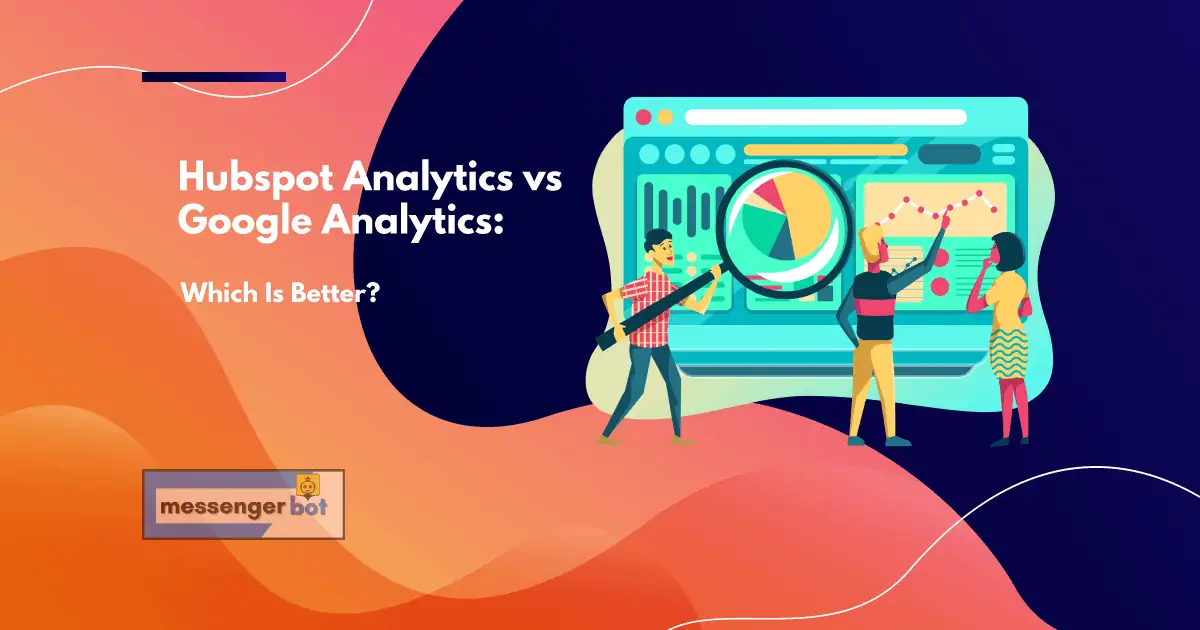Analytics can be a tricky subject. There are so many different analytics suites available, each with its own strengths and weaknesses — but one of the most important questions you need to ask yourself before choosing an analytics suite is: “What do I want to get out of it?”
Which analytics software is better, Hubspot or Google Analytics? This is the question that many marketers are asking themselves. The answer to this question will depend on what your goals are for your business. If you want to know more about how people interact with your website, then you should use Google Analytics. But if you need help with content optimization and marketing automation, then Hubspot might be a better choice for you!
What Are Analytics Tools?
Analytics tools are used to track website traffic.
These tools are meant to help with marketing, so you can see what works and what doesn’t work in your efforts.
Analytics provide the data that is needed for important decisions about content creation, product development, distribution strategy – basically everything! They’re no longer just an “insight tool” but a key part of business operations.

What is Google Analytics?
Google Analytics is an extremely popular website traffic analyzer that can help you see how many people are visiting your site, where they’re coming from (including referrals and keywords), what pages on the site are getting the most activity, how long visitors stay at your site, etc.
You’ll also be able to see how many people are visiting your site from mobile devices, as well as where they’re coming from.
In addition to all this information, you’ll be able to track a bunch of specific events and goals that can help you better understand what’s going on on your website. All of this information is available in real-time, so you can stay on top of things even if you’re not at the office.

What is HubSpot?
HubSpot is a marketing and sales platform that has all the tools you need to grow your business.
Hubspot is different than other analytics platforms because it’s not just an analytics software, but also provides powerful inbound marketing features like blogging, SEO optimization strategies, email automation, social media management, and lead management.
Hubspot makes it easy for users of all levels to understand the data on their website because they have a “human-friendly” interface that’s easier to use than Google Analytics.

Pros of Google Analytics
Google Analytics is free.
Google Analytics provides ample support for businesses of all sizes, making it easy to find answers if you’re having trouble figuring out how to use the tool’s features.
With Google Analytics, you can track your website traffic and conversion rates with ease. You can easily set up goals, monitor your webpage performance, and track revenue.
Google Analytics is available on all devices, so you can see your reports from any location with internet access. You also have the option to download raw data into a spreadsheet for even more detailed analysis if needed!
Pros of HubSpot
HubSpot offers the ability to manage all of your marketing in one place. This includes email, social media, display ads, and other channels that you use to market your business online. It also gives you access to analytics for each platform or channel which can help you determine how effective it is for meeting your goals.
The software offers a large suite of tools that you can use to connect with your customers and create relationships that lead to sales. You get a CRM system, landing pages, website tracking functionality, and more all in one place so it’s easy for marketers of any level of experience or expertise to manage their business online.
HubSpot provides you with the tools needed to put together an effective marketing strategy that can help you grow your business online. It provides a platform for managing all areas of the marketing funnel and analytics to show how effective each area is in meeting goals.
Cons of Google Analytics
Google Analytics is a free tool, but it doesn’t come with as many features as Hubspot.
Google Analytics provides data on how users behave when they land on your website or app from search engines and social media sites. Google does not provide information about the behavior of existing customers who are already loyal to your business or that have purchased products in the past.
Cons of HubSpot
HubSpot has a learning curve.
HubSpot’s interface is not clear and the dashboard can be hard to navigate.
It doesn’t allow you to get into the details of your traffic sources or campaigns.
You aren’t able to drill down into specific channels, which makes it more difficult for teams with multiple marketing people working on different channels at the same time.
HubSpot doesn’t have the ability to edit URLs, so if you need that, it’s not a good fit for your business.
What is HubSpot Used for?
HubSpot is used for lead generation, customer engagement, and marketing. It helps businesses identify their target audience by tracking the behavior of visitors to websites. This can help companies grow awareness through search engine optimization (SEO), make connections with potential customers on social media, manage inbound leads, and understand how website traffic is engaging with content.
What is Google Analytics Used for?
Google Analytics can be used in a variety of ways including but not limited to: measuring and improving marketing campaigns, determining the most effective landing pages for your website’s traffic sources, forecasting future business trends/performance.
Google Analytics is beneficial because it provides insight into customer behavior such as what they are clicking on, how they are navigating your website, and where they drop off.
Many marketers rely on this free tool to track their digital marketing efforts and measure the impact of every dollar spent.
Similarities Between HubSpot and Google Analytics
HubSpot and Google Analytics are both great tools that provide marketers with the information they need to make data-driven decisions.
Besides that, HubSpot and Google Analytics are both similar in that they help marketers achieve their goals.
Both tools provide you with the ability to track visitors, campaigns, traffic sources, conversions, and more.
Overall, both HubSpot’s built-in analytics tool, as well as Google Analytics’ vast data collection capabilities, provide marketers with the insight they need to make data-driven marketing decisions.
Differences Between HubSpot and Google Analytics
While they both serve similar purposes, there are several distinguishing factors to consider when deciding which one is best for your business:
-HubSpot provides a centralized place where you can manage all marketing activities under one roof while Google Analytics is more of a stand-alone platform. Aside from that, both tools provide the ability to track conversions and traffic sources.
-HubSpot is more of a traditional inbound marketing tool while Google Analytics provides insights into visitors’ interactions with your website across multiple channels like paid search, email, social media, etc. Both platforms come equipped with useful reporting features which can be used for tracking ROI (return on investment).
-HubSpot only offers the ability to track social media interactions on Twitter and Facebook, Google Analytics provides data about traffic sources (e.g., blogs, forums, etc.) as well as visitors’ behavior on your websites like page views or bounce rates across all major channels like search engines, social networks, and email marketing. Since it is free, the only drawback is that it does not provide you with as much information about your visitors compared to HubSpot.
Google Analytics vs HubSpot Features Comparison
Choosing an analytics tool can be a daunting task. There are so many things to consider, and it seems like every new tool offers more features than the last one you tried. In this post we’ll compare HubSpot with Google Analytics on some of the most important factors for marketers:
Reporting and analytics
Reporting and analytics are the two main things you should consider when choosing an analytics tool. Using reports can help your company create a roadmap for success and track progress as it happens.
HubSpot Analytics lets users create custom reports and dashboards, which can help them easily visualize data.
Google Analytics provides a variety of standard reports that are easy to use and understand. The user interface is also very intuitive, so owners won’t need any extra training to get started right away.
One downside of HubSpot Analytics is that the Google Data Studio connector doesn’t work, so you have to use their reporting tool. It’s also difficult to build custom reports because it requires coding knowledge and skill, which could be a challenge for some teams.
One downside of Google Analytics is that there are no built-in integrations, so you have to build each one manually. It also doesn’t include detailed event tracking for making sense of user behavior on your website.
It’s important that the reporting and analytics tools allow users to track multiple dimensions in order to get a more holistic view of their data. In addition, it’s helpful if they can filter by custom dimensions and segments so users get the most precise insights possible.

Data integration
Data integration is important in an analytics tool because it allows you to combine information from different sources into one cohesive report. This is useful for businesses that have multiple digital marketing campaigns running at once, or if their website has a longer history of data on which they can draw.
HubSpot Analytics has robust integrations with many popular tools you’re likely already using, including Facebook Ads Manager, Google Analytics, and DoubleClick. Also, it has the option to upload custom data via CSV files.
It’s important to consider whether your business will need time to integrate HubSpot Account Data with other tools, or whether you’re able to integrate them yourself.
Google Analytics has many integrations with popular digital marketing tools including Facebook Ads Manager and DoubleClick for Publishers. However, it does not have direct integrations with any other major services aside from BigQuery. Also, like HubSpot, Google Analytics has the option to upload custom data via CSV files.
Google Analytics does not have a team of professional services experts or an implementation partner network like Hubspot, so you will need to set aside time to integrate it yourself.
HubSpot Analytics and Google Analytics both have integrations with many popular tools, but HubSpot integrates seamlessly without needing to be set up by a third party. Additionally, their integrations are about the same in terms of the effort required for setup and management after it is complete. Also, they both offer an option to upload custom data via CSV files.
HubSpot’s many integrations ensure that you will be able to collect and analyze all your important marketing information in one place, without needing to jump from tool to tool or report on different datasets separately. Google Analytics’ lack of direct integration with other popular digital marketing tools means you will need to do a bit more work to integrate it with your business’s existing processes.
HubSpot Analytics’ integration capabilities pose no significant downsides, but Google Analytics may have some difficulties integrating into businesses that already use several different digital marketing tools.

SEO
SEO is a major factor for any business that wants to be successful.
As many marketers have come to know, Google Analytics is an incredibly useful tool to help understand how visitors are finding your site and what content they’re engaging with on each visit.
However, there’s another player in the analytics game worth considering, especially if you need advanced SEO reporting.
HubSpot’s analytics platform, HubSpot Analytics gives marketers a few additional benefits beyond Google Analytics — namely in the form of SEO reporting metrics and data that aren’t available through other tools.
SEO features are important to understand how well your website is performing for search engines.
HubSpot Analytics provides a number of SEO benefits that Google Analytics does not.
For example, you can see which keywords are driving traffic to your site and how those visits differ from the content they’re engaging with on each visit — both essential insights for marketers looking to improve their organic search performance.
You’ll also have access to keyword rankings data so you can see how your site is ranking for different search terms.
In addition, HubSpot Analytics provides a wealth of information about the pages that are most frequently shared across social media sites and which blog posts have received the most backlinks — two important SEO metrics that Google Analytics doesn’t provide by default.
HubSpot’s analytics platform gives marketers a few additional benefits beyond Google Analytics — namely in the form of SEO reporting metrics and data that aren’t available through other tools.
SEO features are important to understand how well your website is performing for search engines.
Google Analytics is known for its free access to all kinds of reports and insights about website traffic, but it lacks the SEO reporting metrics that HubSpot Analytics provides.
The tool shows you how much organic search is driving your site’s total traffic — something marketers will find useful when trying to understand which keywords are bringing visitors in through Google (and what content they’re engaging with while on your site).
Google Analytics also offers a handful of helpful SEO features to help you better optimize the performance of your website.
For marketers looking to understand how their web pages are performing in search engines, this tool is incredibly valuable — particularly when used alongside other SEO tools like Moz’s free Open Site Explorer and AHrefs (which we’ll discuss in a moment).
Google Analytics is known for its free access to all kinds of reports and insights about website traffic, but it lacks the SEO reporting metrics that HubSpot Analytics provides.
The tool shows you how much organic search is driving your site’s total traffic — something marketers will find useful when trying to understand which keywords are bringing visitors in through Google (and what content they’re engaging with while on your site).
Google Analytics also offers a handful of helpful SEO features to help you better optimize the performance of your website.
When it comes to SEO, HubSpot Analytics provides a number of SEO benefits that Google Analytics does not.

Page Views
Pageviews are one of the most important metrics for businesses. It allows you to track how many visitors are looking at each page on your site, which is useful because it can help you determine what content is working and what isn’t. You may find that certain pages receive more views than others due to their search engine optimization (SEO) or other factors such as word-of-mouth.
HubSpot Analytics allows you to track page views. You can do this by navigating to Content > All Pages, which will display all the pages on your site and how many times they were viewed over a certain period of time (i.e., month, week). The page views report will also show you the average number of times each page is viewed, what content has more views than others, and how many visits on average are generated from each page.
Google Analytics also allows you to track page views. You can do this by navigating to Content > Site Content, which will display all the pages on your site and how many times they were viewed over a certain period of time (i.e., month, week). The main difference between HubSpot Analytics and Google Analytics is that in Google Analytics you have more options to look at the data. For example, you can create a custom report to see which pages are performing better than others based on page views or screen resolution since Google Analytics has different dimensions available.
In terms of page views, both HubSpot Analytics and Google Analytics are great tools to use. The main difference between them is that you have more options with Google Analytics, but both allow you to track page views over time so you can monitor how your website content performs.

Traffic Reporting
Traffic reporting is the most important thing when it comes to analytics. If you are not able to measure how much traffic your site is getting, then how will you know what works and what doesn’t? You need to make sure that every bit of data that goes into making decisions for your business gets analyzed in order for them to be effective.
Since Google Analytics is the most widely used tool, you need to know that there are other tools out there. The best way is to decide what exactly your business needs in order for it to be successful.
Both Google Analytics and Hubspot have their own pros and cons when it comes down to them being compared against each other. While they both measure traffic reporting, there are other features that you need to consider when it comes down to choosing the right one for your business needs.
If you want a tool that is more in-depth and gives you data on things like user behavior, goal conversion rates, sales performance, and lead activity; then Hubspot might be useful since it can do all of these things. However, if you are looking for a tool that is more affordable and will give you just the basic data to measure traffic reporting then Google Analytics would be ideal.
HubSpot Analytics is a great tool that has many useful features as well as an easy-to-use interface. One of the main things it focuses on is traffic reporting and measuring key metrics like visits, page views, unique visitors, and bounce rate. The tool also focuses on measuring lead generation, keeping track of conversions, and identifying the revenue generated from specific pages.
HubSpot Analytics is a great traffic reporting tool that can help you measure your website’s performance at all times. This way you can make decisions about what works for your business best so it will be more successful in the long run.
Google Analytics is a great tool that provides you with plenty of information. The only problem is that it’s not as in-depth when it comes to data, but since most businesses are looking at just basic metrics this should be enough for them to make better business decisions. Traffic reporting has of course been a focal point of Google Analytics since it has always been the main purpose for businesses to get started.
Data is one thing that you are guaranteed when using Google Analytics, but what about other metrics? This will depend on your business needs so if they are looking at things like revenue generated from specific pages or where their traffic comes from then using Google Analytics would be the best choice for them.
In terms of Traffic reporting, HubSpot Analytics and Google Analytics both have their own strong points. It all comes down to what your business needs so you can make better decisions for its success in the long run.
You should always keep in mind that there are other tools out there, so it would be best if you do research and find a tool that fits within your budget while having all of the main features that you are looking for.

Conversion Rates
Conversion rates are a number used to show how many users have completed an action you want them to. For example, if a business wants their visitors to sign up for their email list they can set it as the desired action and then check in Google Analytics what percentage of people who visited that page signed up. This conversion rate could be one metric your analytics tool reports.
The higher the percentage, the more people completed your desired action and vice versa. Conversion rates can be used to help you determine what content is most effective at getting visitors to complete a certain goal or task on your website. Once you know that, then you can focus on creating even better content around those ideas!
HubSpot Analytics takes conversion rates to the next level. When you set up goals in Google Analytics, they are limited to conversions that happen on your website (i.e., if someone buys something from your site). But with HubSpot’s new Goals feature, you can track how many people use a specific feature or complete certain tasks within any of your marketing channels including email, social media, and more. You can also track other metrics like how many people download a certain file or complete an online form.
Google Analytics’ conversion rates feature allows you to track your website or app’s goal conversion rates. The metrics available for tracking depend on the type of site and any customizations made which include tracking offline conversions like phone calls. Aside from that, you can also track your social media conversions.
In terms of Conversion Rates, HubSpot Analytics has more features to make it easier for you to track your users’ behavior and how they interact with your marketing channels. An example would be if someone downloads a specific file on an e-commerce site, this conversion rate could show up.
In Google Analytics, you have to set up a custom goal in order for conversion rate data to be tracked. This isn’t as easy and straightforward when HubSpot’s Goals feature automatically tracks this information without any additional work from marketers or business owners.

Goal Setting
Goal setting is an important function of any business analytics tool. This is because it allows your company to determine where they want the product or service to be and what you expect from them in return for that investment. It makes sure that there is a direct correlation between growth and ROI which will help businesses create specific, quantifiable goals to track their success with each campaign or project.
To set the appropriate goals for your business, you should have a clear understanding of what each campaign is trying to accomplish and how it can measure its success at meeting that goal.
HubSpot Analytics allows you to set goals for each piece of content that is created. When the goal has been met, it will track how many visits your site received from this particular source and what actions they took on the website once there. This information can then be used in order to determine if a new campaign or project was successful based on its performance metrics.
Google Analytics also has a goal-setting function that allows you to track specific metrics for individual pieces of content and how they impact your overall site. These goals can be set at either the page level or product category in order to determine if certain products receive more attention than others or which pages are the most popular.
HubSpot has a goal-setting feature that allows you to set goals based on actions taken by your users while Google’s is more focused on tracking certain pages or categories of products from within their site. Both have functions that allow for specific metrics to be tracked which helps companies determine if their campaigns are successful or not.
In order to track your success, you need to have specific goals that correlate directly to the ROI and the growth of your product/service. It is important to understand the differences between each tool so you can set up tracking for both your website and campaigns in order to measure their impact.

User Interface
User Interface (UI) is the part of a website, application, or other product that users interact with to access its functions and features. The UI also allows for interactions between the user and machine (e.g., sensors). In the world of web analytics tools, it refers to how easy they are to use when analyzing your website’s data.
HubSpot Analytics has a very clean and easy-to-use UI. The user interface is one of the main reasons why people like this tool so much: it’s straightforward, visually appealing, and doesn’t take any time to get used to.
HubSpot Analytics’ User Interface allows you to see all relevant data about your website. On the left-hand side of the page, there is a list of “reports” (or categories) that can be customized according to what you want to analyze and track on your website. For example, Social Media Performance shows information like how many visitors you got from social media channels in a month, what was the traffic source that brought these people to your website, and how many conversions did you get from them. The UI is very well organized so finding any data point or piece of information will take less than five clicks away from where you are currently located on the page.
Google Analytics’ UI is a bit more advanced and requires some understanding of data. The “default” view of Google Analytics shows you all the main traffic sources (e.g., organic search, paid advertising, social media) and allows you to see how many visitors they brought to your website in a month. If that’s not enough for you then it becomes a bit more complicated. You need to go into the “Audience” section and then click on a single source (e.g., organic search). Once you do that, you will be able to see how many new visitors each of your pages got from this particular traffic source in a month. For example, if I clicked on Organic Search as a traffic source then I would see all the pages that got new visitors from organic search in a month.
In terms of User Interface, HubSpot Analytics is much easier to use than Google Analytics. That’s why it has gained so much popularity among people who are just starting their analytics journey. If you want something more advanced then Google Analytics might be the better choice for you!

Ease of Use
Ease of use is important for both businesses and marketers alike. If a tool is difficult to use, it can either lead to not completing tasks or leave the user confused on what exactly they are supposed to do with the information provided. Ease of Use is crucial to determining which tool is better, especially for business owners.
HubSpot Analytics has an easy-to-navigate layout that allows marketers of all levels to easily view, track and share reports. The tool even has pre-built templates for the most common marketing tasks which can be customized based on individual needs.
Hubspot analytics is simple enough to use for marketing teams of any size, while still providing enough advanced features to satisfy the needs of agencies and large companies. It has all the necessary tools marketers need in an easy-to-use interface that takes little training time to understand.
Google Analytics has a simple interface that is easy to understand. Its ease of use feature may be its strongest selling point.
Google analytics’ popularity makes it the go-to tool for many marketers, especially those who are not familiar with advanced marketing software tools. Its easy-to-use interface will allow you to gain valuable knowledge quickly and easily, allowing you to meet your marketing goals promptly.
Google Analytics may be easier for new marketers to use, but it lacks many of the features that make HubSpot so valuable. Its simple interface limits what can be done with the data and reports. It also lacks many of the integrations that HubSpot offers.
In terms of Google Analytics, its ease of use features makes it easy to get started quickly. However, as your marketing needs grow more complex and you begin looking for a more comprehensive tool that can help you meet those needs, HubSpot analytics is the way to go!

Frequently Asked Questions
How does HubSpot determine a session?
HubSpot determines a session when there are no more than 30 minutes between any two events. A new session begins after a 30-minute break, which means that you may have multiple sessions within one longer session depending on the length of time spent without an event occurring.
How does Google Analytics determine a session?
Google Analytics determines a session when someone visits your website. This is typically done through the use of cookies or other similar tracking technologies which are embedded on each page on your site so that it can record information about how people interact with the content. It’s important to note, though, that a session is typically considered over if someone leaves the site and returns.
How can you use both to get the best results?
When using both, you need to make sure that they are working in harmony. This can be done through a process called “cleansing” the data from each system before adding it together for analysis.
With Hubspot Analytics vs Google Analytics, one must focus on which features they need to use for their business.
The best way to do this is by creating a list of features that are most important and then determining which one will work better with your current strategy.
For instance, if you’re trying to create sales tools from the data collected in Analytics, Hubspot Analytics will be more useful.
On the other hand, if you want to market your business through social media channels like Instagram and Facebook, Google Analytics is a great place to start.
Which is better, HubSpot Sessions vs Google Analytics Sessions?
The best analytic software in terms of sessions is Google Analytics.
However, HubSpot is good for beginners and people who want to get more involved in marketing analytics.
Some people prefer HubSpot because it comes with a marketing automation platform. It’s pretty easy to get started and has some good features for beginners, but the learning curve is steeper than Google Analytics’.
If you’re new to analytics or don’t have much experience in web development then Hubspot might be your best option. However, if you’re a little more experienced and want to get your hands dirty with customizing the analytics set-up then Google is probably for you.
Which analytics solution should you use?
The best analytic solution to use is the one that works best for you.
The best analytic solution to use is the one that works best for your business needs. This might be Hubspot Analytics or Google Analytics, but it could also be another analytics package depending on what features are important to you and how much of an investment you’re willing to make.





